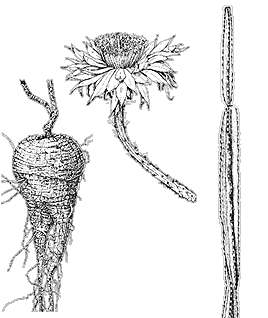Genus Peniocereus
Peniocereus greggii
English names: desert night-blooming cereus, Arizona queen-of-the-night
Spanish names: saramatraca,
reina-de-la-noche
Description
The stems of this cactus are usually few in number, thin and barely succulent, to about 3 feet (1 m) tall. The plant grows from a large, starchy underground tuber that can occasionally weigh more than 40 pounds (18 kg). The nocturnal white flowers are about 3 inches (8 cm) across with very long floral tubes, and are strongly scented. (Some people canít smell them.) They close soon after the morning sun reaches them.
 |
Range
This cactus can be found in Southern Arizona to southern Texas and adjacent northern Mexico, as well as in Baja California.
Notes
The plants grow under desert ironwood, creosote bush, and other desert shrubs; the stems are extremely difficult to distinguish from those of the shrubs that provide shade, physical support, and concealment. When the stems are eaten by herbivores such as white-throated woodrats (packrats) and cactus borers (Cactobrosis fernaldialis), new stems soon sprout from the tuberous root.
This is one of the Sonoran Desertís most famous yet least encountered plants. It is virtually invisible most of the year, but on a few nights it becomes stunningly conspicuous. Some experienced field botanists spent months scouring a small tract of land to locate and tag all of the plants for an ecological study. Then on a night when the plants flowered they found enough new plants to double their known population size.
Plants in each population bloom in synchrony; large ones can produce a score of flowers at once. The legend is that they all bloom on a single night per year. Reality is almost as intriguing: each plant produces only 3 to 5 flushes of flowers between late May and early July. During each flush most of the flowers open on one night, with a few stragglers the night before or after the big bang.
In ideal cultivated situations where the plants are protected from predators, these cacti can grow hundreds of times larger than they do in nature. Archaeologist Julian Hayden had a plant in his Tucson yard that was over 8 feet (2.4 m) tall and perhaps twice as wide. Its great tangle of stems produced 200 flowers on one night and another 100 on the following night.
Desert night-blooming cereus plants usually occur as widely-separated individuals, and the flowers are not self-fertile. The flowers are cross-pollinated by hawk moths (Sphingidae) which fly hundreds of yards between plants in their search for the nectar reward. The cactus fruit turns red when ripe, attracting birds that eat the pulp and disperse the seeds in their droppings. The root is used medicinally to treat diabetes and other maladies.
This cactus is a desert version of the canary in the coal mine, an early warning that something is wrong in the ecosystem. Where pesticides are heavily used in agricultural areas adjacent to natural habitat, the hawkmoth populations are devastated and most of the flowers fail to fruit. This is an example of chemical habitat fragmentation; the habitat appears to be intact, but some of its ecological processes have been destroyed or degraded.











